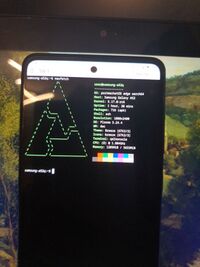Samsung Galaxy A52 4G (samsung-a52q)
This means that it cannot be selected in pmbootstrap.
Status: dropped in pma!5177
 The Samsung Galaxy A52 4G running Plasma Mobile on postmarketOS with a mainline Kernel, showing the result of running neofetch | |
| Manufacturer | Samsung |
|---|---|
| Name | Galaxy A52 4G |
| Codename | samsung-a52q |
| Released | 2021 |
| Type | handset |
| Hardware | |
| Chipset | Qualcomm Snapdragon 720G (SM7125) |
| CPU |
Octa-Core; 2x2.3 GHz Kryo 465 Gold 6x1.8 GHz Kryo 465 Silver |
| GPU | Adreno 618 |
| Display | 1080 x 2400 Super AMOLED |
| Storage | 128 / 256GB |
| Memory | 4 / 6 / 8GB |
| Architecture | aarch64 |
| Software | |
Original software The software and version the device was shipped with. |
Android 11 |
Mainline Instead of a Linux kernel fork, it is possible to run (Close to) Mainline. |
no |
Flashing It is possible to flash the device with pmbootstrap flasher. |
Works
|
|---|---|
USB Networking After connecting the device with USB to your PC, you can connect to it via telnet (initramfs) or SSH (booted system). |
Works
|
Battery Charging and battery level reporting works |
Partial
|
Screen Display works. Ideally with sleep mode and brightness control. |
Partial
|
Touchscreen |
Works
|
| Multimedia | |
3D Acceleration |
Works
|
Audio Audio playback, microphone, headset and buttons. |
Partial
|
Camera |
Broken
|
| Connectivity | |
WiFi |
Works
|
Bluetooth |
Works
|
GPS |
Broken
|
NFC Near Field Communication |
Broken
|
| Modem | |
Calls |
Untested
|
SMS |
Works
|
Mobile data |
Works
|
| Miscellaneous | |
FDE Full disk encryption and unlocking with unl0kr. |
Untested
|
USB OTG USB On-The-Go or USB-C Role switching |
Broken
|
| Sensors | |
Accelerometer Auto screen rotation works in desktops e.g. Phosh or Plasma Mobile |
Broken
|
| This device is based on the Qualcomm Snapdragon 720G (SM7125). See the SoC page for common tips, guides and troubleshooting steps |
Contributors
Users owning this device
- Chaosleo07 (Notes: ITS BACK AGAIN! found a cheap replacement mainboard, work shall continue)
- Hilledkinged (Notes: Recently gotten and looking to play around with it)
How to enter flash mode
Press and hold + while plugging it in the Computer. Then click to confirm.
Unlocking the Bootloader
!!!WARNING!!!
This will reset your device to Factory settings and blow the Knox E-Fuse! You have been warned.
Samsung made this easy (thankfully): Reboot into Download mode (hold down Vol+ and Vol- while plugging it into a computer) and hold down Vol+.
This way, you can also relock the bootloader (with the only benefit being that the message at the Beginning is gone, no more Knox)
Installation
First, install pmbootstrap.
After that, set up the device to be used:
$ pmbootstrap init
Channel [edge]:
Vendor [samsung]: samsung <- enter this
Device codename [i9100]: a52q <- enter this
Enable this package? (y/n) [y] <- you probably want non-free firmware
User interface [plasma-mobile]: <- choose any UI by your preference. Plasma Mobile works without issues :)
...
Then, create the rootfs image (and install it on sd card if you want)
$ pmbootstrap install (--sdcard=/dev/whatever_your_sdcard_is if you want to install to sd card)
After that, flash the kernel by doing
$ pmbootstrap flasher flash_kernel
and if you didn't install to an SDCard, flash the rootfs by running
$ pmbootstrap flasher flash_rootfs
After installation download emptyDTBO.img and flash using heimdall or TWRP.
Status table explanation
This table explains more in detail why some features are marked as partial (P) or Broken (N). Generally it's because feature works with some limitations, or is a "work-in-progress":
| Component | Status | Notes |
|---|---|---|
| Screen | P | Changing brightness causes graphical artifacts(It's recommended to disable automatic brightness control) |
| Audio | P | Only audio from built in stereo speakers works. |
| Calls | N | Can recieve and make calls but call audio missing. |
Notes
Issues with DEs etc.:
- framebufferphone: has issues with Touch
- xorg: doesn't work/crashes on adreno 618 (wayland/xwayland works fine)
See also
- pmaports!3379 Merge Request for the device